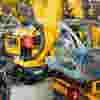Use the correct oil
In injected screw compressors, oil plays an integral role. You should always ensure that you choose an oil that is the correct type for your installation. Genuine OEM oil is always the best choice as it helps to maintain the integrity of your system and keeps your compressor running smoothly and efficiently.
Check for oil and air leaks
Leaks in your system can drastically decrease efficiency and ultimately cost you money. Leak detection surveys can be carried out by expert aftermarket engineers who use ultrasonic leak detection technology to quickly and easily identify leaks in the system.
Regularly inspect the airend
Your airend should generally last around 44,000 hours if maintained correctly. Factors such as overheating, poor lubrication, condensation and corrosion can cause damage to the airend which may result in malfunction or breakdown. Regularly checking for any issues with the airend can help you to diagnose and fix a problem early on.
Check hoses regularly
Check your compressors hoses periodically to ensure they are not cracked or corroded, this could result in a leak which may reduce energy efficiency and ultimately cost you money.
Drain condensation from air receiver tanks
Regularly draining your receiver tanks will keep it clean and running smoothly. A build-up of moisture could be detrimental to your compressed air output.
Check and change air filters
If your air filter is not performing effectively, it may be allowing dirt and dust particles from the outside in. This will force your compressor to work harder to intake air. If you notice a build-up of dust, you may want to consider replacing your air filter.
Please watch this video to see the airend in action










